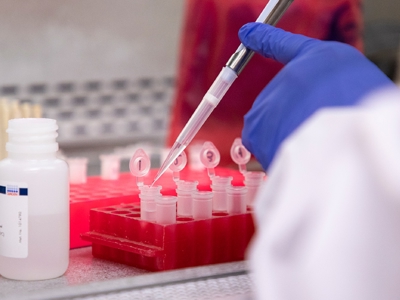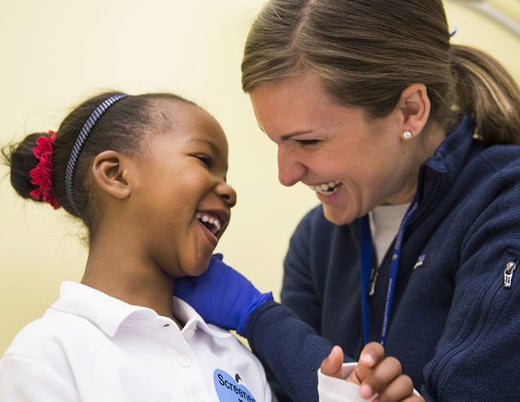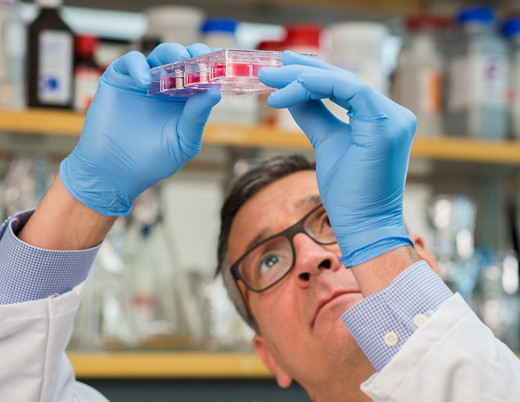Could tiny magnetic "microwheels" be the latest breakthrough in treating strokes?
In more than a quarter of stroke patients, conventional treatment options are ineffective at breaking up blood clots. Keith Neeves, PhD, is working to change that through a potential new treatment dubbed “microwheels.” These rotating clusters of magnetic beads that can be guided toward clots using magnetic fields have already produced impressive results in animal models: A clot that might have taken an hour to break up now takes about a minute.
A fantastic voyage
In the 1965 film “Fantastic Voyage,” a group of scientists shrinks to microscopic size to navigate a tiny submarine through a defected soviet spy’s vasculature, saving him from a massive stroke by using lasers to break up a blood clot in his brain.
“That’s the origin of this idea,” says bioengineer Keith Neeves, PhD.
Inspired by the film, Neeves has spent the last eight years working with a cross-disciplinary team of mathematicians, biologists, clinicians, nurses, engineers, students and postdocs to find new approaches to treating strokes that occur in small blood vessels. Instead of a shrink ray and lasers though, Neeves employs tiny magnetic beads that, when exposed to a rotating magnetic field, form what he calls “microwheels.”
Neeves hopes that one day these magnetic beads — made of plastic and iron oxide and roughly the size of a blood cell — can be injected into a patient’s blood stream and directed toward blood clots. Once in their wheel configuration, the particles act as a swarm, and by altering the magnetic field, Neeves can control the swarm’s behavior.
“Over the years, we've figured out ways to manipulate that magnetic field to make the wheels do all kinds of different things,” Neeves explains. “We can get them to roll in any direction and there's some modes where they're good at climbing walls. There are other modes where they're good at penetrating into surfaces and there are modes where they roll really fast.”
The magnetic field is powered by copper wire repurposed from audio speakers, which is wrapped around cylinders that Neeves can control with a simple joystick. As he moves the field, the swarm of microwheels follows suit.
Expanding access and care
This accessible, affordable technology could have any number of applications, but Neeves and his team are currently focused on using the microwheels to dissolve stroke-inducing blood clots. According to Neeves, stroke treatment has long been stagnant and relies heavily on just one FDA-approved drug with significant side effects. Strokes can also be treated using thrombectomy catheters, which are inserted into blood vessels to manually rip a clot out. To access this treatment though, patients must be lucky enough to live near a hospital that has the necessary suite of tools and expertise.
What’s more, 25 to 30% of strokes occur in small blood vessels, which are difficult to reach with catheters and often don’t get enough blood flow to successfully deliver clot-busting pharmaceuticals. This is a problem in children with strokes too, whose blood vessels are much smaller than their older counterparts.
That’s where Neeves’ science-fiction approach could one day make all the difference. With its use of recycled audio materials and its simple infrastructure, it could expand access to care, and its medical benefits are twofold.
“It's not just dumping the drug there at the side of the clot. It actually drives into the clot because we have this mechanical force that allows us to penetrate into the clot,” Neeves says. “And so rather than dissolving something just at the surface like sandpaper, what we do is we actually drive them in, and it dissolves the clot from the inside out. It gets a Swiss cheese confirmation and the rate at which we can dissolve the clot is much faster.”
A product of collaboration
So far, this technology has only been tested in animal models, but the results are promising. Neeves and his team have decreased clot-busting time using a combination of microwheels and thrombolytic therapy by a factor of 50 over thrombolytic therapy alone.
This outcome, Neeves says, is the product of dozens of people in a variety of fields coming together in one cohesive space to solve a pressing, though underappreciated, problem. This collaboration is only possible at places like the Anschutz Medical Campus, which in addition to housing Children’s Colorado, also includes the University of Colorado School of Medicine.
“Being on this campus, being able to leverage the different facilities we have, and just the human capital is unique,” he says. “There's only a handful of places in the country where you can do this kind of work.”
Organ on a chip
When it comes to running new tests and experiments, most researchers rely on animal models. But a new scientific movement takes human-derived cells and grows important features of an organ in a lab. In Neeves’ case, this means taking endothelial cells, which line human blood vessels, and growing them inside tubes the size of a human hair.
“We can grow them inside of these little tubes and then apply different kinds of insults to them, run blood through them and watch clots form,” Neeves says. “You can see these clots forming at the cellular scale, which is hard to do inside of an animal or inside of a person. And then we have total control over everything.”
The goal of this work is to eventually achieve personalized medicine. One day Neeves hopes that he can recreate an individual patient’s exact situation through this process and test different treatments to determine the best option for them.
Mathematical models of clotting
Working with applied mathematicians at Colorado School of Mines and University of Utah, Neeves has created mathematical models that allow him to run 100,000 clotting simulations in just a few minutes. Neeves says the idea is that if they can build strong mathematical models, they can use the information as a screening tool to better understand how the composition of someone’s blood might affect its ability to clot or not, particularly in the case of hemophilia.
“You can think about it as having hundreds of knobs on a control panel and then randomly turning them all,” Neeves explains. “The model pulls out these key tweaks and says, ‘If you turn this knob and this knob, then we get this really interesting and maybe counterintuitive result.”
Using statistical methods, Neeves’ team extracts the most interesting findings and uses experimental methods to verify them. The results go right back into the model, making it better and smarter over time. Most recently, this approach alerted Neeves’ team to a possible novel modifier of bleeding in hemophilia. They validated that finding via experimentation and are now diving into whether that finding is a potential therapeutic target.
Featured Researchers

Keith Neeves, PhD
Professor
University of Colorado - Denver





 720-777-0123
720-777-0123













